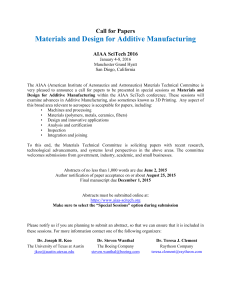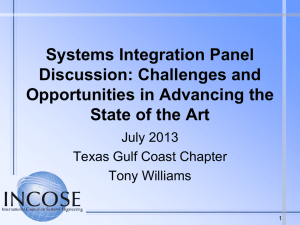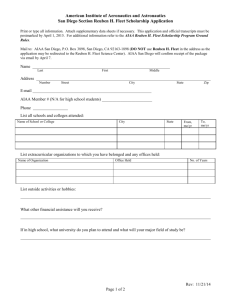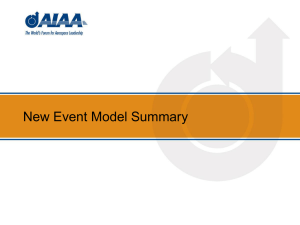(0701) Survivability (TC)
advertisement
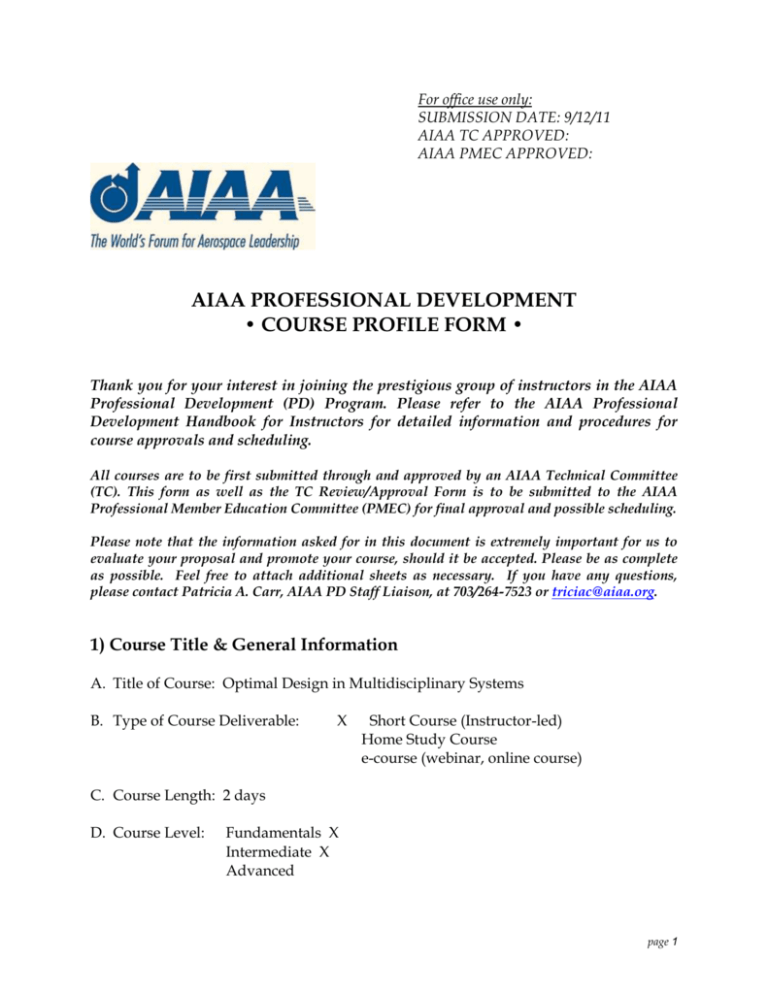
For office use only: SUBMISSION DATE: 9/12/11 AIAA TC APPROVED: AIAA PMEC APPROVED: AIAA PROFESSIONAL DEVELOPMENT • COURSE PROFILE FORM • Thank you for your interest in joining the prestigious group of instructors in the AIAA Professional Development (PD) Program. Please refer to the AIAA Professional Development Handbook for Instructors for detailed information and procedures for course approvals and scheduling. All courses are to be first submitted through and approved by an AIAA Technical Committee (TC). This form as well as the TC Review/Approval Form is to be submitted to the AIAA Professional Member Education Committee (PMEC) for final approval and possible scheduling. Please note that the information asked for in this document is extremely important for us to evaluate your proposal and promote your course, should it be accepted. Please be as complete as possible. Feel free to attach additional sheets as necessary. If you have any questions, please contact Patricia A. Carr, AIAA PD Staff Liaison, at 703/264-7523 or triciac@aiaa.org. 1) Course Title & General Information A. Title of Course: Optimal Design in Multidisciplinary Systems B. Type of Course Deliverable: X Short Course (Instructor-led) Home Study Course e-course (webinar, online course) C. Course Length: 2 days D. Course Level: Fundamentals X Intermediate X Advanced page 1 E. Which AIAA Technical Committee approved this Course? Multidisciplinary Design (please refer to Section 4-b of the interest codes. The “TC” indicates an active technical committee) E. At which AIAA technical conference(s) should this course be held in conjunction with or is it best as a stand-alone course? 2) Instructor(s) Information Please provide information for all instructors. Identify the Lead Instructor or Point of Contact. If there are multiple instructors for this course, AIAA will communicate with the Lead Instructor and that person will disseminate relevant information to the other instructors. A. Lead Instructor/Point of Contact: Name Prabhat Hajela Address 4010 Walker Labs Address Rensselaer Polytechnic Institute City Troy State New York Zip 12180 Telephone _518-276-6624 Fax 518-276-8062 Email address hajelap@rpi.edu In a narrative/paragraph form, please provide a 50-word biography on each instructor. Also please send a complete resume. Prabhat Hajela, Ph.D., is a Professor at the Rensselaer Polytechnic Institute in Troy, New York. He holds a B.S. in Aeronautical Engineering from the Indian Institute of Technology, an M.S. in Aeronautical Engineering from Iowa State University, an M.S. in Mechanical Engineering and a Ph.D. in Aeronautics & Astronautics from Stanford University. Prior to joining RPI, he taught at the University of Florida for six years, and has done research assignments at the NASA Langley Research Center, NASA Lewis Research Center, U.S. Air Force Armament Labs, and at the University of California in Los Angeles. Hajela is a Fellow of the AIAA, ASME and AeSI, and a recipient of the AIAA MDO Award in 2004. B. Other Instructors: Name Dr. J.E. Sobieski Address NASA Langley Research Center page 2 City Hampton State Virginia Zip 23665 Telephone ______________________ Fax ______________________ Email address _________________________________________________________ In a narrative/paragraph form, please provide a 50-word biography on each instructor. Also please send a complete resume. Jaroslaw Sobieski, Ph.D., holds three degrees: a B.S., M.S., and Ph.D. in Aeronautical Engineering from the Technical University of Warsaw. Before joining the staff of NASA Langley Research Center in 1979, he taught at the Technical University of Warsaw, St. Louis University, and George Washington University. Dr. Sobieski is currently a Senior Researcher at NASA Langley Research Center. He also teaches George Washington University students at the NASA site. Dr. Sobieski received the AIAA MDO Award in 1996, and a NASA Medal for Exceptional Engineering Achievement in 1988. Note: please adhere to the word or bullet limit. If it exceeds the limit, it is to our discretion to edit. Name ________________________________________________________________ Address ______________________________________________________________ Address ______________________________________________________________ City _______________________________ State ______________ Zip ___________ Telephone ______________________ Fax ______________________ Email address _________________________________________________________ In a narrative/paragraph form, please provide a 50-word biography on each instructor. Also please send a complete resume. Note: please adhere to the word or bullet limit. If it exceeds the limit, it is to our discretion to edit. 3) Course Content Description A. In narrative form, please provide brief symposia of this course (150 words or less). When you are designing or evaluating a complicated engineering system such as an aircraft or a launch vehicle, can you effectively reconcile the multitude of conflicting requirements, interactions, and objectives? This course discusses the underlying challenges in such an environment, and introduces you to methods and tools that have been developed over the years. You will be presented with a review of the state-of-the-art methods for disciplinary optimization that exploit the modern computer technology for applications with large numbers of variables, page 3 design limitations, and many objectives. You will learn how to evaluate sensitivity of the design to variables, initial requirements, and constraints, and how to select the best approach from many currently available. From that disciplinary level foundation, the course will take you to system level applications where the primary problem is in harmonizing the local disciplinary requirements and design goals to attain the objectives required of the entire system, and where performance depends on the interactions and synergy of all its parts. In addition to imparting skills immediately applicable, the course will give you a perspective on emerging methods and development trends. B. In bullet format, please provide key topics/learning objectives of the course (no more than 6 bullets). Multidisciplinary design-components, challenges, and opportunities Optimization methods and Sensitivity analysis Decomposition in multidisciplinary design Surrogate Modeling in Design Soft computing methods in optimal design Uncertainty in Multidisciplinary Design C. In bullet format, please provide a detailed outline including subheadings (no more than 30 lines). Overview of MDO Methods o Analysis o Optimization o Strategies Review of Numerical Methods of Optimization o Gradient and Non-Gradient Based Methods o Methods of Sensitivity Analysis MDO Solutions Through Decomposition o Hierarchical & Non Hierarchical Methods o Coordination Strategies o Surrogate Modeling o Complex Systems Soft Computing Methods o Genetic Algorithms and Other Heuristic Methods for Optimization o Neural Networks/SVM for Function Approximation Reliability Based Design o Problems Formulations in Presence of Uncertainty o Efficient Solution Strategies for Reliability Based Design page 4 Note: please adhere to the word or bullet limit. If it exceeds the limit, it is to our discretion to edit. 4) Course Audience/Market A. In narrative form, give a brief paragraph on the audience intended for this course (50 words or less) Note: please adhere to the word or bullet limit. If it exceeds the limit, it is to our discretion to edit. Design engineers and technical managers involved with preliminary or detailed design of aerospace, mechanical, and other multidisciplinary engineering systems will find this material applicable in their work environment. Advanced research students and research scholars in academia and in research laboratories will also benefit from the topics covered in this course. They would use this material as an entry point into possible areas of further research. B. Which Professional Interests apply to your Course (see below for codes)? • Indicate the Primary Professional Interest Market: ___0775__________ • Indicate the Secondary Professional Interest Market: ___0130__________ • Indicate the Tertiary Professional Interest Market ____710_________ ENGINEERING & TECHNOLOGY MANAGEMENT (0100) Economics (TC) (0105) History (TC) (0110) Legal Aspects of Aeronautics and Astronautics (TC) (0115) Management (TC) (0120) Society & Aerospace Technology (TC) (0130) Systems Engineering (TC) (0135) Environmental Assurance/Compliance (0140) Computer-Aided Enterprise Solutions (TC) AEROSPACE SCIENCES (0200) Aeroacoustics (TC) (0210) Applied Aerodynamics (TC) (0215) Astrodynamics (TC) (0220) Atmospheric & Space Environment (TC) (0225) Atmospheric Flight Mechanics (TC) (0235) Fluid Dynamics (TC) (0240) Guidance, Navigation & Control (TC) page 5 (0245) Aerodynamic Measurement Technology (TC) (0250) Plasmadynamics & Lasers (TC) (0255) Sounding Rockets (0265) Thermophysics (TC) (0270) Remote Sensing & Applications (0275) Therodynamics (0280) Computational Fluid Dynamics (0285) Modeling & Simulation (TC) (0290) Ground Testing (TC) (0295) Meshing, Visualization & Computational Environments (TC) AIRCRAFT & ATMOSPHERIC SYSTEMS (0300) Air Transportation Systems (TC) (0305) Aircraft Design (TC) (0310) Aircraft Operations (TC) (0315) Aircraft Safety (0316) Balloon Technology (TC) (0320) General Aviation Systems (TC) (0325) Helicopter Design (0330) Lighter-Than-Air Systems (TC) (0335) Unmanned Systems (0340) V/STOL Aircraft Systems (TC) (0345) Marine Systems & Technology (0350) Multidisciplinary Design Optimization (0355) Hypersonic Systems (0360) Flight Testing (TC) (0365) Electronic Equipment Design (0370) Ground Support Equipment (0375) Aircraft Maintenance (0380) Reliability (0385) Test & Evaluation (0390) Standards Engineering (0395) Producibility & Cost Engineering (0396) Production Engineering (0397) Aerodynamic Decelerator Systems (TC) INFORMATION SYSTEMS (0400) Aerospace Electronics (0405) Aerospace Maintenance (0410) Intelligent Systems (TC) (0420) Information & Command & Control Systems (TC) (0425) Communications Systems (TC) (0430) Computer Systems (TC) page 6 (0435) Digital Avionics Systems (TC) (0440) Sensor Systems (TC) (0445) Software Systems (TC) (0450) Support Systems (0455) System Effectiveness & Safety (0460) Space Logistics (0465) Micro/Nanotechnology PROPULSION & ENERGY (0500) Aerospace Power Systems (TC) (0510) Electric Propulsion (TC) (0515) Liquid Propulsion (TC) (0520) Propellants and Combustion (TC) (0525) Solid Rockets (TC) (0530) Terrestrial Energy Systems (TC) (0535) Nuclear Thermal Propulsion (TC) (0540) Hybrid Rockets (TC) (0545) Energetic Components & Systems (TC) (0550) Gas Turbine Engines (TC) (0555) High Speed Air Breathing Propulsion (TC) (0560) Air Breathing Propulsion Systems Integration (TC) SPACE & MISSILE (0600) Life Sciences & Systems (TC) (0605) Missiles Systems (TC) (0610) Space Operations & Support (0615) Microgravity & Space Processes (TC) (0620) Space Systems (TC) (0625) Space Transportation (TC) (0630) Space Sciences & Astronomy (0635) Space Automation & Robotics (TC) (0640) Weapon Systems Effectiveness (TC) (0645) Human Factors Engineering (0650) Satellite Design, Integration & Test (0655) Launch Operations (0660) Laser Technology (0665) Space Tethers (TC) (0670) Space Colonization (TC) (0675) Space Tourism (0680) Terraforming (0685) Space Resources (TC) (0690) Space Architecture (TC) (0695) Space Logistics (TC) page 7 Aerospace Design & Structures (0701) Survivability (TC) (0705) Design Engineering (TC) (0710) Design Technology (0735) Materials (TC) (0745) Structural Dynamics (TC) (0750) Structures (TC) (0755) Adaptive/Smart Structures (TC) (0760) Radar Absorbing Materials&Structures (0770) Non-Deterministic Approaches (TC) (0775) Multidisciplinary Design Optimization (TC) C. Which Company Codes apply to your Course? • Indicate the Primary Business Code: __1A,1B, 1C,1D,___________ • Indicate the Secondary Business Code: ____2A_________ • Indicate the Tertiary Business Code: ____5A_________ AEROSPACE MANUFACTURING (1A) Military Aircraft (1B) Commercial Aircraft (1C) Business & Private Aircraft (1D) Helicopters (1E) Missiles (1F) Spacecraft (1G) Powerplant & Propulsion Systems (1H) Avionic/Electronic Component & Subsystems (1I) Electro/Mechanical Systems (1J) Hydraulic /Pneumatic Systems (1K) Flight Controls & Instrumentation (1L) Other Parts/Components & Subsystems (3B) Business & General Aviation SUPPLIERS GOVERNMENT (2A) Department of Defense (2A1) US Army (2A2) US Air Force (2A3) US Navy (2A4) US Marine Corps (2B) NASA (2C) Other Federal, State & Local (2D) Non-US Government (2D1) Non-US Military AIR TRANSPORTATION (3A) Trunk, Regional & International (4A) Materials (4B) Engineering Manufacturing Equipment (4B1) Computers (4B2) Software or SERVICES (5A) Consulting or Government Service Contracting (5B) Science, Research & Developing, or Contracting (5C) Education (6) Others Allied to this Field page 8 C. What other technical societies, companies, government agencies, conferences attendee lists, requests for reprints, departmental or company mailing lists, etc. would likely find your course relevant to their members’/companies’ areas of interest. (please list) D. Can you provide mailing lists? No E. List any other courses being offered that, to your knowledge, are similar to this course or that you think may compete with the course. (List their titles, and instructors.) Nothing that competes directly but a former co-instructor Dr. G.N Vanderplaats teaches a course in Design Optimization through his company that has elements of this course included in the curriculum. 5) Course Content Life Cycle/Relevance What is the likely development process and expected life cycle of this course? Is this course time sensitive? How much funding has there been and expected? …Please provide a brief summary of the life cycle and trend of this topic. The field of MDO has been robust as is evidenced by the continuing presence of a large number of researchers worldwide working in one or another aspect of this discipline. In addition to annual AIAA sponsored conferences in the field (MDO Specialist Meeting and the AIAA MDO Meeting in alternate years), there is also an International Conference on Structural & Multidisciplinary Optimization that is held every two years. Two other smaller competing conferences, based in UK and France respectively, also attract researchers in this field. Companies have moved to embrace the results of this research and are interested in having their research engineers and staff trained more thoroughly in the field. This type of demand has produced the most number of attendees in our course in its previous offerings. As with any other field, the subject matter of interest changes with shifting focus, and the course has attempted to maintain its relevance in this fast moving field. 6) Course Requirements A. Is there a textbook required with your course? If so, provide author, title list price and publisher as well as any purchase discounts that AIAA could obtain in conjunction with this course. No textbook is required for the course. B. Are there any computer requirements for this course? If so, please give full information. Have you designed any software programs to accompany your course? page 9 If so, please describe as fully as possible. AIAA makes notes available electronically and it helps students with computers to follow along and annotate as required. C. Are there any other requirements, other than course notes, that students will need to complete the course? No 7) Testimonials We use testimonials, or endorsements, from qualified, eminent individuals for promotional use. These endorsements are solicited by you, and are important to attract potential students. Please provide us with their names, titles, business affiliations, addresses, and telephone numbers. 8) Originality &ITAR Compliant What other educational organizations or training groups you are offering your course? Only through the AIAA - Professor Hajela also teaches this course infrequently as a graduate course at Rensselaer Polytechnic Institute in Troy, New York. A. CLEARANCE The accompanying notes/handouts, books, and/or lecture are UNCLASSIFIED (for public release) and have been cleared for release by the appropriate agencies, company, or government. The course materials have been determined to be in the public domain as defined in the International Traffic in Arms Regulation. B. NO-INFRINGEMENT STATEMENT Please make unambiguous the copyright status of any published material, course notes, or handouts, by signing the following affidavit assuring us that it contains no copyright-infringing material. The published material, course notes, or handouts are represented as original work by the instructor(s). No portion of the material is covered by a prior copyright or for any portion that may be copyrighted, the author has obtained permission for its use. The instructor owns the course materials and contents. page 10 C. AIAA Instructor Agreement I have read the AIAA Professional Development Handbook and will comply with the contents of the Handbook and to the processes and procedures set forth by the AIAA Board of Directors and the AIAA Professional Member Education Committee. Signature of Lead Instructor Date page 11
